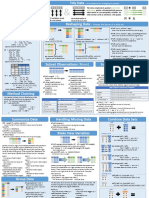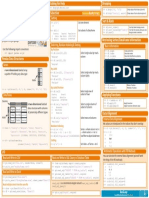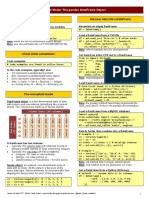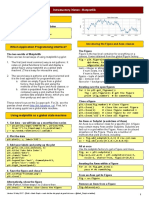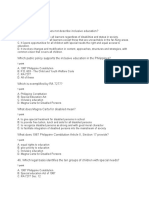Python Seaborn Cheat Sheet
Uploaded by
Frâncio RodriguesPython Seaborn Cheat Sheet
Uploaded by
Frâncio RodriguesPython For Data Science Cheat Sheet 3 Plotting With Seaborn
Seaborn Axis Grids
Learn Data Science Interactively at www.DataCamp.com >>> g = sns.FacetGrid(titanic, Subplot grid for plotting conditional >>> h = sns.PairGrid(iris) Subplot grid for plotting pairwise
col="survived", relationships >>> h = h.map(plt.scatter) relationships
row="sex") >>> sns.pairplot(iris) Plot pairwise bivariate distributions
>>> g = g.map(plt.hist,"age") >>> i = sns.JointGrid(x="x", Grid for bivariate plot with marginal
>>> sns.factorplot(x="pclass", Draw a categorical plot onto a y="y", univariate plots
y="survived", Facetgrid data=data)
Statistical Data Visualization With Seaborn hue="sex",
data=titanic)
>>> i = i.plot(sns.regplot,
sns.distplot)
The Python visualization library Seaborn is based on >>> sns.lmplot(x="sepal_width", Plot data and regression model fits >>> sns.jointplot("sepal_length", Plot bivariate distribution
y="sepal_length", across a FacetGrid "sepal_width",
matplotlib and provides a high-level interface for drawing hue="species", data=iris,
attractive statistical graphics. data=iris) kind='kde')
Categorical Plots Regression Plots
Make use of the following aliases to import the libraries: >>> sns.regplot(x="sepal_width", Plot data and a linear regression
Scatterplot
>>> import matplotlib.pyplot as plt y="sepal_length", model fit
>>> sns.stripplot(x="species", Scatterplot with one
>>> import seaborn as sns data=iris,
y="petal_length", categorical variable
data=iris) ax=ax)
The basic steps to creating plots with Seaborn are: >>> sns.swarmplot(x="species", Categorical scatterplot with Distribution Plots
y="petal_length", non-overlapping points
1. Prepare some data data=iris) >>> plot = sns.distplot(data.y, Plot univariate distribution
2. Control figure aesthetics Bar Chart kde=False,
color="b")
3. Plot with Seaborn >>> sns.barplot(x="sex", Show point estimates and
y="survived", confidence intervals with Matrix Plots
4. Further customize your plot hue="class", scatterplot glyphs
>>> sns.heatmap(uniform_data,vmin=0,vmax=1) Heatmap
data=titanic)
>>> import matplotlib.pyplot as plt Count Plot
>>>
>>>
>>>
import seaborn as sns
tips = sns.load_dataset("tips")
sns.set_style("whitegrid") Step 2
Step 1
>>> sns.countplot(x="deck",
data=titanic,
Show count of observations
4 Further Customizations Also see Matplotlib
palette="Greens_d")
>>> g = sns.lmplot(x="tip", Step 3
Point Plot Axisgrid Objects
y="total_bill",
data=tips, >>> sns.pointplot(x="class", Show point estimates and >>> g.despine(left=True) Remove left spine
aspect=2) y="survived", confidence intervals as >>> g.set_ylabels("Survived") Set the labels of the y-axis
>>> g = (g.set_axis_labels("Tip","Total bill(USD)"). hue="sex", rectangular bars >>> g.set_xticklabels(rotation=45) Set the tick labels for x
set(xlim=(0,10),ylim=(0,100))) data=titanic, >>> g.set_axis_labels("Survived", Set the axis labels
Step 4 palette={"male":"g", "Sex")
>>> plt.title("title")
>>> plt.show(g) Step 5 "female":"m"}, >>> h.set(xlim=(0,5), Set the limit and ticks of the
markers=["^","o"], ylim=(0,5), x-and y-axis
linestyles=["-","--"]) xticks=[0,2.5,5],
1
Boxplot yticks=[0,2.5,5])
Data Also see Lists, NumPy & Pandas >>> sns.boxplot(x="alive", Boxplot
Plot
y="age",
>>> import pandas as pd hue="adult_male",
>>> import numpy as np >>> plt.title("A Title") Add plot title
data=titanic)
>>> uniform_data = np.random.rand(10, 12) >>> plt.ylabel("Survived") Adjust the label of the y-axis
>>> sns.boxplot(data=iris,orient="h") Boxplot with wide-form data
>>> data = pd.DataFrame({'x':np.arange(1,101), >>> plt.xlabel("Sex") Adjust the label of the x-axis
'y':np.random.normal(0,4,100)}) Violinplot >>> plt.ylim(0,100) Adjust the limits of the y-axis
>>> sns.violinplot(x="age", Violin plot >>> plt.xlim(0,10) Adjust the limits of the x-axis
Seaborn also offers built-in data sets: y="sex", >>> plt.setp(ax,yticks=[0,5]) Adjust a plot property
>>> titanic = sns.load_dataset("titanic") hue="survived", >>> plt.tight_layout() Adjust subplot params
>>> iris = sns.load_dataset("iris") data=titanic)
2 Figure Aesthetics Also see Matplotlib
5 Show or Save Plot Also see Matplotlib
>>> plt.show() Show the plot
Context Functions >>> plt.savefig("foo.png") Save the plot as a figure
>>> f, ax = plt.subplots(figsize=(5,6)) Create a figure and one subplot >>> plt.savefig("foo.png", Save transparent figure
>>> sns.set_context("talk") Set context to "talk" transparent=True)
>>> sns.set_context("notebook", Set context to "notebook",
Seaborn styles font_scale=1.5, Scale font elements and
>>> sns.set() (Re)set the seaborn default
rc={"lines.linewidth":2.5}) override param mapping Close & Clear Also see Matplotlib
>>> sns.set_style("whitegrid") Set the matplotlib parameters Color Palette >>> plt.cla() Clear an axis
>>> sns.set_style("ticks", Set the matplotlib parameters >>> plt.clf() Clear an entire figure
{"xtick.major.size":8, >>> sns.set_palette("husl",3) Define the color palette >>> plt.close() Close a window
"ytick.major.size":8}) >>> sns.color_palette("husl") Use with with to temporarily set palette
>>> sns.axes_style("whitegrid") Return a dict of params or use with >>> flatui = ["#9b59b6","#3498db","#95a5a6","#e74c3c","#34495e","#2ecc71"]
with to temporarily set the style >>> sns.set_palette(flatui) Set your own color palette DataCamp
Learn Python for Data Science Interactively
You might also like
- Learning The Pandas Library Python Tools For Data Munging Analysis and Visual PDF100% (18)Learning The Pandas Library Python Tools For Data Munging Analysis and Visual PDF208 pages
- Pandas 1.x Cookbook - Second Edition: Practical recipes for scientific computing, time series analysis, and exploratory data analysis using Python, 2nd EditionFrom EverandPandas 1.x Cookbook - Second Edition: Practical recipes for scientific computing, time series analysis, and exploratory data analysis using Python, 2nd Edition5/5 (1)
- Hands-On Web Scraping with Python: Perform advanced scraping operations using various Python libraries and tools such as Selenium, Regex, and othersFrom EverandHands-On Web Scraping with Python: Perform advanced scraping operations using various Python libraries and tools such as Selenium, Regex, and othersNo ratings yet
- Python Programming, Deep Learning: 3 Books in 1: A Complete Guide for Beginners, Python Coding for Ai, Neural Networks, & Machine Learning, Data Science/Analysis with Practical Exercises for LearnersFrom EverandPython Programming, Deep Learning: 3 Books in 1: A Complete Guide for Beginners, Python Coding for Ai, Neural Networks, & Machine Learning, Data Science/Analysis with Practical Exercises for Learners4/5 (4)
- Methods of Incremental Loading in Data Warehouse25% (4)Methods of Incremental Loading in Data Warehouse5 pages
- Python Cheat Sheet: Pandas - Numpy - Sklearn Matplotlib - Seaborn BS4 - Selenium - Scrapy100% (3)Python Cheat Sheet: Pandas - Numpy - Sklearn Matplotlib - Seaborn BS4 - Selenium - Scrapy9 pages
- Matplotlib Tutorial Learn Matplotlib by Examples B08XYJB9K3100% (5)Matplotlib Tutorial Learn Matplotlib by Examples B08XYJB9K3204 pages
- Cheat Sheet: The Pandas Dataframe Object: Preliminaries Get Your Data Into A Dataframe100% (1)Cheat Sheet: The Pandas Dataframe Object: Preliminaries Get Your Data Into A Dataframe12 pages
- Introductory Notes: Matplotlib: PreliminariesNo ratings yetIntroductory Notes: Matplotlib: Preliminaries11 pages
- Hands-On Data Analysis with Pandas: Efficiently perform data collection, wrangling, analysis, and visualization using PythonFrom EverandHands-On Data Analysis with Pandas: Efficiently perform data collection, wrangling, analysis, and visualization using PythonNo ratings yet
- The Python Workshop: Learn to code in Python and kickstart your career in software development or data scienceFrom EverandThe Python Workshop: Learn to code in Python and kickstart your career in software development or data science5/5 (1)
- Pandas in 7 Days: Utilize Python to Manipulate Data, Conduct Scientific Computing, Time Series Analysis, and Exploratory Data AnalysisFrom EverandPandas in 7 Days: Utilize Python to Manipulate Data, Conduct Scientific Computing, Time Series Analysis, and Exploratory Data AnalysisNo ratings yet
- Data Analysis with Python: Introducing NumPy, Pandas, Matplotlib, and Essential Elements of Python Programming (English Edition)From EverandData Analysis with Python: Introducing NumPy, Pandas, Matplotlib, and Essential Elements of Python Programming (English Edition)No ratings yet
- Python Internals for Developers: Practice Python 3.x Fundamentals, Including Data Structures, Asymptotic Analysis, and Data TypesFrom EverandPython Internals for Developers: Practice Python 3.x Fundamentals, Including Data Structures, Asymptotic Analysis, and Data TypesNo ratings yet
- Impact of Workplace Motivation On Employee Performance Research Proposal0% (1)Impact of Workplace Motivation On Employee Performance Research Proposal9 pages
- Lesson 4 Latest Studies and Trends in Teaching EPP100% (1)Lesson 4 Latest Studies and Trends in Teaching EPP8 pages
- Regressor Instruction Manual - (W) - 03No ratings yetRegressor Instruction Manual - (W) - 03434 pages
- Earthing System Design - Moving From Worst Case To The Big Picture PDFNo ratings yetEarthing System Design - Moving From Worst Case To The Big Picture PDF10 pages
- Pitch Deck: CMIE3013: Product Innovation & Entrepreneurship I100% (1)Pitch Deck: CMIE3013: Product Innovation & Entrepreneurship I64 pages
- Part 1. Listen To A Talk About "Driverless Cars". Decide Whether TheNo ratings yetPart 1. Listen To A Talk About "Driverless Cars". Decide Whether The11 pages
- Jakarta Is Sinking. Here's How To Stop ThisNo ratings yetJakarta Is Sinking. Here's How To Stop This2 pages
- Memoryranger Prevents Hijacking File - ObjecNo ratings yetMemoryranger Prevents Hijacking File - Objec10 pages
- Design, Simulation and Implementation of Very Compact Dual-Band Microstrip Bandpass Filter For 4G and 5G ApplicationsNo ratings yetDesign, Simulation and Implementation of Very Compact Dual-Band Microstrip Bandpass Filter For 4G and 5G Applications4 pages
- TLE 8 2nd Quarter Reviewer With Answer KeyNo ratings yetTLE 8 2nd Quarter Reviewer With Answer Key10 pages
- GALPA MYLENE D. SCHOOL BASED PLANNING AND MANAGEMENT Written ReportNo ratings yetGALPA MYLENE D. SCHOOL BASED PLANNING AND MANAGEMENT Written Report6 pages

















